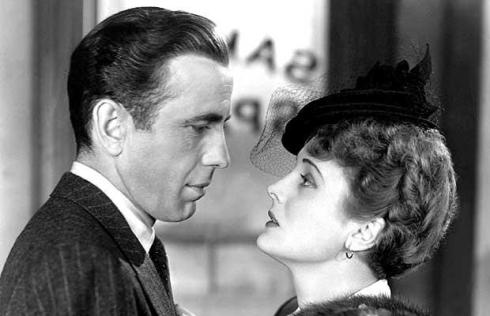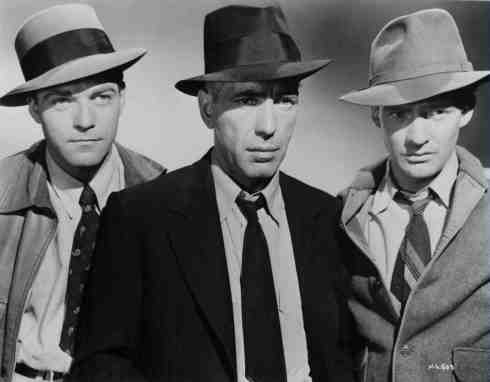
If the stars suddenly aligned on an especially dark night and I was given the chance to remake the film of my choice, I wouldn’t hesitate to tell the movie gods I will do The Maltese Falcon. And if such a cinematic fate befell me, my adaptation would include one special passage in Dashiell Hammet’s novel that has never been translated to film even though at least three film Falcons have soared into movie theaters since the novel debuted in 1930.

Noir fans call it the “Flitcraft Parable” found in Chapter 7: G in the Air — a short digression completely unrelated to the novel’s plot in which Sam Spade, tells Brigitte O’Shaunessy a little story about a man named Flitcraft.

In the story, Spade explains how Flitcraft, a real estate agent and family man living in Tacoma goes to lunch one day never to return. Five years go by and his wife comes to the detective agency where Spade is working with news: someone in Spokane has seen a man resembling her husband. She retains Spade to track him down only to discover that it is indeed Flitcraft.

Flitcraft tells Spade the day he went to lunch, he had walked by an office building under construction and a huge beam fell from eight to ten stories up, impaling itself into the sidewalk right beside him. The experience of nearly being killed had a profound effect on Flitcraft, jarring him out of his very existence for a moment. As Spade explains:
“He felt like somebody had taken the lid off life and let him look at the works,” says Spade. “The life he knew was a clean orderly sane responsible affair. Now a falling beam had shown him that life was fundamentally none of these things.”

Flitcraft had left for Seattle that day without any provisions or extra cash. To his family, it was as if he had simply disappeared off the face of the earth. Flitcraft moved around a little bit before eventually coming back to Washington State where he married again – to a woman very much in appearance and temperament as his first wife – and started a new family. Spade concludes the story with a final thought:
“I don’t think he even knew he had settled back naturally in the same groove he had jumped out of in Tacoma,” says Spade. “But that’s the part of it I always liked. He adjusted himself to beams falling, and then no more of them fell, and he adjusted himself to them not falling.”

I know why no filmmaker before me has ever seen the need to keep this digression in their movie version of The Maltese Falcon. It’s because on the surface of it, the Flitcraft Parable has nothing specifically to do with the larger plot of The Maltese Falcon. But if you think about it in terms of Spade’s character and, by extrapolation, author Hammett – you see that it has everything to do with how Spade is able to prevail in almost any situation put before him.

Sam Spade is a master of observation. A student of human behavior with the uncanny ability to boil life down to its barest and most basic essentials at any given moment. He’s able to see a situation by any given angle and point of view from whichever character he finds in the room. He knows that once you strip away love, desire, greed, lust, rage and romanticism from any equation – you are left with the truth: what we do with our lives is largely insignificant in the larger scheme of things.

Who we love or hate, who we back and who we resist, will be most certainly be forgotten soon after we shed this mortal coil. That thought, whether delivered by steel beam from the heavens or a loved one’s untimely departure, whether by ugly divorce, chronic illness or natural catastrophe – is coming for each and every human who has ever lived. And when faced with our own mortality, we humans tend to react with varying forms of panic, fear, terror and desperation.

What is less common, however, and what is so magical and I believe cinematic about Hammett’s Flitcraft Parable is not so much what the character of Flitcraft does – but how and why Sam Spade is telling the story in the first place. Spade is telling Brigitte that he (Spade) perceives life to be a game at best, a cosmic joke at worst. We’re lucky to even be alive, walking the earth so why take things so seriously? And at the same time, Spade plays the game well, better than anyone else and that includes her. And because of this high-powered perception, he knows that she is bad, playing him for a sap, a chump. He’ll play along as long as it amuses him, to see how it all ends up. Because what’s love when there’s a steel beam 30 stories up just waiting to fall with your number on it. Might as well enjoy life before it falls and that includes playing chess with the likes of a beautiful femme fatale.

THE MALTESE FALCON, Elisha Cook, Jr., Sydney Greenstreet, Humphrey Bogart, Mary Astor, 1941
In the end of The Maltese Falcon, Sam Spade’s greatest fear is not death but being made a fool. And he’ll resist being her fool because as he tells her, “all of me wants to.” Spade could give Gandhi a run for his money when it comes to resisting an urge. He’s a professional, after all, with a job to do. And when death does come for him as it will all of us , you better believe he’ll stare into the Grim Reaper’s eye-sockets and grin back at him. Now that’s dark, people. It’s why I love Noir because it doesn’t hold back on the reality of the human condition – but pushes it kicking and screaming into the center of the spotlight.

We’re all going to die, so we might as well enjoy ourselves and have a little fun. That’s why Noir as a genre is more than alive as well. Why Hammett’s Flitcraft Parable would be right at home in recent existential fare such as TRUE DETECTIVE (can’t you see Matthew McConaughey’s character regaling The Flitcraft Parable to an annoyed Woody Harrelson?) or even THE DARK KNIGHT’s JOKER character played by the late, great Heath ledger. That’s the power of classic Noir, to strike a chord in every human’s fibrous, meaty core and question why each one of us are here and why the hell we take everything so damn seriously.

Take Hammett and Spade’s word for it. Life is a game so enjoy it for what it’s worth and remember to play the game well while you have the time. Because you better believe the competition are playing for keeps – and no one likes to be made a fool of.

Tags: Dashielle Hammett, Heath Ledger, Humphrey Bogart, Mary Astor, Matthew Mcconaughey, The Dark Knight, True Detective, Woody Harrelson
 Lead character Mad Dog Earle is a cold-blooded killer at the beginning of High Sierra (1941). But by the end he’s helped heal a disabled young woman and fallen hard for a cocktail dancer named Marie (Ida Lupino), in a rare noir western that would be the breakthrough film cementing Humphrey Bogart’s A-List Star status. Unlike Private Investigator Sam Spade, the main character in the Maltese Falcon, also made in 1941 and starring Bogart, Roy Earle is a hardened criminal. The character is the literal half-way point for Bogie’s evolution from B-movie gangster tough guy to screen preeminence as ultra-cool, bowtie and tuxedo wearing Rick Blaine in Casablanca (1942).
Lead character Mad Dog Earle is a cold-blooded killer at the beginning of High Sierra (1941). But by the end he’s helped heal a disabled young woman and fallen hard for a cocktail dancer named Marie (Ida Lupino), in a rare noir western that would be the breakthrough film cementing Humphrey Bogart’s A-List Star status. Unlike Private Investigator Sam Spade, the main character in the Maltese Falcon, also made in 1941 and starring Bogart, Roy Earle is a hardened criminal. The character is the literal half-way point for Bogie’s evolution from B-movie gangster tough guy to screen preeminence as ultra-cool, bowtie and tuxedo wearing Rick Blaine in Casablanca (1942).


















